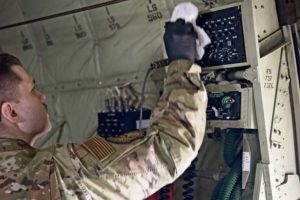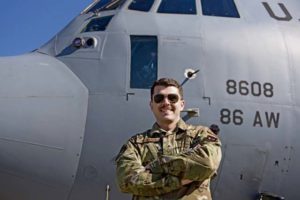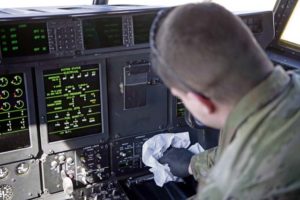
Airmen assigned to the 86th Aircraft Maintenance Squadron carried out newly implemented disinfection procedures on all C-130J Super Hercules aircraft flights prior to departure and upon arrival on Ramstein Air Base, April 1.
The Center for Disease Control and National Institutes of Health have repeatedly referenced “flattening the curve” in regard to containing coronavirus disease 2019. In epidemiology, flattening the curve describes an ideal situation where the spread of the virus is slowed, resulting in fewer people who need treatment at any one given time. Doing so alleviates some of the stress endured by hospitals and their staff, globally.
The now common practice of physical distancing, and the disinfection of every C-130J Super Hercules aircraft performed by the 86th AMXS are both actions designed to combat the spread of COVID-19 and help flatten the curve.

“Disinfection of these aircraft has high priority due to the large amount of traffic we see every day,” said U.S. Air Force Senior Airman Kyle Hodge, 86th AMXS flying crew chief. “The disinfection procedures started after concern for COVID-19 emerged on a worldwide scale.”
Disinfection of an aircraft differs from the decontamination process used in chemical, biological, radiological and nuclear emergencies. Using a bottle of 70-to-30 percent alcohol-to-water cleaning solution, disinfecting a C-130J Super Hercules aircraft includes taking measures such as sanitization of high-touch points, to include handrails, seat belts and static lines.
“Primarily, disinfection focuses on these high-touch points,” said U.S. Air Force Capt. Ryan Putnam, 37th Aircraft Maintenance Unit officer in charge. “Disinfection focuses more-so on preventative measures before a COVID-19 case appears, while decontamination would be something utilized in the event COVID-19 is confirmed on a C-130J Super Hercules.”

As far as semantics go, one might argue an area needing disinfection is a contaminated area, and an area needing decontamination is an infectious one. To the layman, the terms might seem interchangeable; but to the aircraft maintainers, disinfection means maintaining a preventative posture before the presence of COVID-19 and decontamination means exposure mitigation after it shows up.
In a perfect world, the decontamination procedures won’t ever be needed. Regardless, members of the 86th AMXS are prepared should they become necessary.







